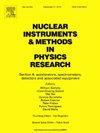Next generation multi-element monolithic Germanium detectors for spectroscopy: First integration at ESRF facility
IF 1.5
3区 物理与天体物理
Q3 INSTRUMENTS & INSTRUMENTATION
Nuclear Instruments & Methods in Physics Research Section A-accelerators Spectrometers Detectors and Associated Equipment
Pub Date : 2025-07-17
DOI:10.1016/j.nima.2025.170835
引用次数: 0
Abstract
The XAFS-DET work package of the European LEAPS-INNOV project is developing high-purity Germanium detectors for synchrotron applications requiring spectroscopic-grade response. The detectors integrate three key features: (1) newly designed monolithic Germanium sensors optimized to mitigate charge-sharing events, (2) an improved cooling and mechanical design structure supported by thermal simulations, and (3) complete electronic chain featuring a low-noise CMOS technology based preamplifier, enabling high X-ray count rate capability over a broad energy range (5–100 keV). This paper discusses the first integration and characterization of one of the two multi-element Ge detectors at the European Synchrotron Radiation Facility (ESRF). The integration phase included validating high-throughput front-end electronics, integrating them with the Ge sensor, and operating them at liquid nitrogen temperature, in addition to the experimental characterization, which consists of electronics noise study and spectroscopic performance evaluation.
用于光谱学的下一代多元素单片锗探测器:ESRF设施的首次集成
欧洲leap - innov项目的XAFS-DET工作包正在开发用于需要光谱级响应的同步加速器应用的高纯度锗探测器。探测器集成了三个关键特征:(1)新设计的单片锗传感器,优化了电荷共享事件;(2)改进的冷却和机械设计结构,支持热模拟;(3)完整的电子链,采用基于低噪声CMOS技术的前置放大器,在宽能量范围(5-100 keV)内实现高x射线计数率。本文讨论了欧洲同步辐射设施(ESRF)两个多元素锗探测器之一的首次集成和表征。集成阶段包括验证高通量前端电子器件,将其与Ge传感器集成,并在液氮温度下运行,此外还有实验表征,包括电子噪声研究和光谱性能评估。
本文章由计算机程序翻译,如有差异,请以英文原文为准。
求助全文
约1分钟内获得全文
求助全文
来源期刊
CiteScore
3.20
自引率
21.40%
发文量
787
审稿时长
1 months
期刊介绍:
Section A of Nuclear Instruments and Methods in Physics Research publishes papers on design, manufacturing and performance of scientific instruments with an emphasis on large scale facilities. This includes the development of particle accelerators, ion sources, beam transport systems and target arrangements as well as the use of secondary phenomena such as synchrotron radiation and free electron lasers. It also includes all types of instrumentation for the detection and spectrometry of radiations from high energy processes and nuclear decays, as well as instrumentation for experiments at nuclear reactors. Specialized electronics for nuclear and other types of spectrometry as well as computerization of measurements and control systems in this area also find their place in the A section.
Theoretical as well as experimental papers are accepted.

 求助内容:
求助内容: 应助结果提醒方式:
应助结果提醒方式:


